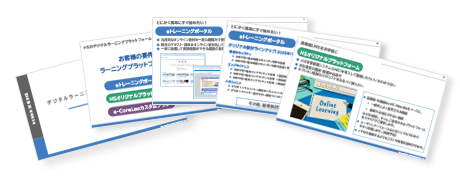2023.08.30
2023.11.14
What are the 5 key points to successfully implement e-learning? We also explain the benefits and implementation steps.

"We have implemented e-learning, but we do not feel its effectiveness"
"Employees are not actively trying to learn"
Do you have such concerns?
The COVID-19 pandemic has brought e-learning into the spotlight as a system for workforce training that accommodates new ways of working.
However, there may be companies that have struggled with the use of e-learning and have switched systems in search of convenience. To successfully implement an e-learning system that meets your company's needs and lead internal training to success, there are key points to keep in mind.
This article introduces five key points for successfully implementing e-learning. It also summarizes the benefits of implementation and methods for doing so.
1. What is e-Learning?
First, let's review e-learning.
E-learning is an educational system that utilizes IT technology
E-learning generally refers to a method of learning or an entire educational system that uses computers, tablets, or smartphones through an internet connection.
E-learning is said to have originated in the 1950s in the United States with the research and development of computer-assisted education known as "CAI (Computer Aided Instruction)". In the 1990s, it evolved into "CBT (Computer Based Training)" which involved conducting tests on computers. Subsequently, it developed into "WBT (Web Based Training)" which delivers educational materials over the internet. The term "e-learning" began to be used in the 2000s.
Generally, learning takes the form of watching video content or solving problems using dedicated learning apps.
In particular, video materials are widely used in corporate in-house training. Video materials display screens composed of photos, illustrations, and animations, allowing learners to listen to explanatory audio and read subtitles while studying. Since video formats are highly compatible with smartphones and easy to learn from, there has been a growing demand recently for short video materials that summarize key points in about 1 to 2 minutes.
Learning management for participants is possible on the e-learning platform
As e-learning becomes widely adopted, learning management systems (LMS) that can manage not only the delivery of educational materials but also track learning progress are being utilized by many companies and organizations. The "LMS" is also referred to as an "e-learning platform" because it can centrally manage multiple educational materials and related information.
The e-learning platform allows for tests tailored to learning levels and surveys aimed at problem-solving. Therefore, support can also be provided to maintain each individual's learning motivation.
We provide a detailed explanation of e-learning platforms in the article below. Please refer to it.
> What is the best e-learning platform for your company? An explanation of features, types, and benefits!

2. Benefits of Implementing e-Learning
By implementing e-learning, companies can promote employee learning and provide equal opportunities for skill development. Additionally, unlike group training, it can reduce costs associated with travel for instructors and participants, as well as venue setup.
Provide learning to employees regardless of time and place
By implementing e-learning, we can provide employees with a wide range of learning opportunities. In group training, participants need to adjust their schedules and gather at a designated location.
However, with e-learning, there are no constraints of time or place, allowing you to study at a convenient time. For example, if you have short video materials, you can watch them during travel time at work, making it efficient to absorb knowledge.
Standardize education
E-learning allows for the same educational content to be provided to all participants, leading to the standardization of education.
If you are a restaurant chain, you must ensure consistency in service and food quality. Therefore, we provide e-learning materials such as service manuals, cooking methods, and recipes. All staff at each location can check these materials at the necessary time without the need to distribute them to each store or send instructors.
Additionally, by eliminating differences that may arise from the content and teaching methods of different instructors, there is an advantage of being able to provide the same training to all staff.
When conducting tests, the exact same questions are presented, leading to proper evaluations and ensuring employee satisfaction.
Leads to cost reduction in instructor fees, venue costs, and travel expenses
E-learning can be studied online, reducing costs for instructors, venue fees, and travel expenses for participants.
When conducting training by inviting instructors to the actual venue, the quality of the training tends to be influenced by the instructor's experience and knowledge. Typically, if you want to choose a reputable instructor, a certain budget is necessary. By the way, it has also been reported that it costs about 4 times more compared to e-learning.
We must also consider the costs incurred by the participants.
For example, what if a company with branches nationwide conducts group training for employees at a certain level? The number of participants is likely to be considerable.
First, it is necessary to secure a venue that accommodates the number of participants.
Additionally, travel expenses to the venue and, in some cases, accommodation costs will also be required.
With e-learning, there are advantages in cost reduction since there are no expenses for instructors, venues, or travel.
Centralized management of learning progress
By using the e-learning platform (LMS), you can manage your learning progress. Furthermore, it has a system that allows for follow-up even with differences in understanding.
For example, based on the data accumulated in the e-learning platform, you can conduct tests or surveys, allowing you to provide the most suitable education for each participant.
At Human Science, we produce e-learning materials tailored to the needs of companies. We also provide support for the implementation and operation of LMS.
We distribute helpful materials that can be downloaded for free. Additionally, you can view case studies of e-learning service implementations, which we hope will be useful when considering the introduction of e-learning.
> E-learning Service Implementation Case Studies and Helpful Material Downloads

3. Flow until the introduction of e-learning
What is necessary to actually implement e-learning?
Generally, the following steps are required.
1. Clarify the purpose of implementation
2. Define the target audience
3. Establish management and operational systems
4. Select an e-learning platform
5. Prepare the system and environment
6. Start implementation and operation
Let's take a look at each one.
1. Clarify the purpose of implementation
First, let's clarify the purpose of implementing e-learning.
For example, the following points can be mentioned.
●Human Resource Development
●Promotion of Skill Enhancement
●Reduction of Education Costs
It is important to determine the purpose of implementation based on management issues. By considering what knowledge and skills you want employees to acquire, you can deduce what materials should be provided, allowing for meticulous planning. Additionally, employees themselves will be motivated to learn, as they can acquire skills that can be applied to their work, ultimately leading to personal skill enhancement and, consequently, advancement for the company as a whole.
For example, let's say a company has set the purpose of implementation as "to optimize internal organization and functions."
This company is considering the establishment of an inside sales department to promote "the segmentation of operations" in its sales strategy. It has been decided that the basic knowledge of inside sales will be learned through e-learning.
In such cases, by incorporating the usage of the sales support system that is planned for future implementation and the call manual as teaching materials, the achievement of the implementation purpose can be expected.
Human Science creates custom e-learning materials based on over 2,600 achievements. We can create materials tailored to your company's needs, including translation and localization support.
You can request free materials from the link below. Please feel free to contact us.
> Click here for the contact form
2. Clarify the target audience
Next, we will determine the target audience for the e-learning. This includes whether it is for all employees, new hires, or a specific department.
It is similar to an internal training plan.
After implementing the e-learning platform, operations will be conducted, and the materials provided can be changed based on the target audience, as well as the combination of materials.
The e-learning platform allows for the registration of participant information and user registration. At that time, it is important to determine the criteria that will identify the target audience for the education and ensure that all relevant information is registered.
For example, the following items are common.
●Name・Date of Birth
●Affiliated Organization
●Job Title
●Employment Type
●Year of Joining
By entering this kind of information, even when new materials are added, it will be easier to narrow down the target audience each time, allowing for the continuous provision of the most suitable materials.
3. Establish a management and operational system
Establishing an appropriate management and operational system is important for achieving the objectives of e-learning implementation. Especially during the initial phase of implementation, issues such as "unable to log in to the platform" and "unable to view the materials" are likely to occur. It is advisable to consider establishing a help desk to respond quickly and maintain the momentum of learning.
In addition, the e-learning platform requires regular system updates. The roles of the administrators and the workflow should also be clearly defined in advance.
Let's build a smooth management and operational system.
4. Select an e-learning platform
It is recommended to choose an e-learning platform that offers a trial (demo) period, as the services, features, and support systems vary by provider. Try out multiple e-learning platforms during the trial to select the one that is user-friendly.
The e-learning platform is available in two types: "on-premises" which is installed on our own servers, and "cloud-based" which is accessed via the internet. Additionally, the method of system construction varies by service.

Full scratch development, which involves building a system from the ground up, allows for the creation of a custom system that meets all requirements. However, it is time-consuming and labor-intensive, resulting in relatively high implementation costs. On the other hand, open-source solutions can reduce implementation costs while providing access to basic functionalities, and they also offer the advantage of customization as needed.
Human Science supports the implementation of the open-source learning management system "Moodle." We provide support from implementation to operation, offering assistance throughout the process. The article below introduces the basic usage of "Moodle."
>[Moodle Basic Course] What can the e-learning management system Moodle do?
5. Prepare the system and environment
Once the e-learning platform is decided, we will prepare the environment by building the system and other necessary components. The method of constructing the environment will vary depending on whether the platform is "on-premises" or "cloud-based."
In the case of open-source types, if the system is in place, construction can also be carried out in-house. However, if there are errors in security-related settings or communication environments during implementation, it may lead to troubles at the start of the course. Therefore, when implementing for the first time, it is recommended to receive support from specialized service providers for initial settings and such.
Additionally, even for open-source types, some providers may offer not only support during implementation but also support for a certain period.
6. Start Implementation and Operation
Once the environment is set up, we are finally ready to start operations, but there are several important preparations to be made here as well.
Let's establish a trial period before going live. By conducting necessary tests during the trial period, we can reduce the likelihood of issues occurring after the start of operations.
Additionally, let's create manuals for all participants to promote understanding and awareness. Furthermore, after the operation begins, we will conduct surveys with participants to identify issues. It is important to operate while making necessary corrections and improvements as needed.

4. Five Key Points for Successfully Implementing e-Learning
Here are five points to successfully implement e-learning and achieve your goals.
1. Choose the optimal e-learning platform
E-learning platforms play an important role in achieving objectives. First, let's gather information, including case studies and user reviews. Once you have narrowed down your options, as mentioned earlier, you will conduct a trial. Even during the trial period, if there are any concerns, no matter how small, be proactive in confirming and resolving them.
If possible, we recommend trying multiple e-learning platforms and selecting one based on a multifaceted evaluation considering their use, purpose, compatibility with your company's environment, budget, and cost-effectiveness.
2. Choose a service with operational support
After implementation, it is necessary to consider operational support in case of any issues. Depending on the scale and nature of the problems, prompt responses may be required, making operational support essential.
Creating a comfortable learning environment without troubles also helps maintain the motivation of the participants.
We recommend service providers that not only assist with the implementation but also offer long-term support after the operation begins.
3. Select or create teaching materials suitable for the company
There are points to consider when providing e-learning materials to participants.
Methods for procuring materials include purchasing existing materials, customizing existing materials, and creating original materials. Purchasing existing materials is the easiest option, but even partially, the content may not be suitable for your company's training. Therefore, it is convenient to be able to customize materials by incorporating unique elements or editing them as needed.
If you are implementing your own unique training, you can either produce it in-house or request production from a specialized vendor. Existing materials from your company may be useful for creating teaching materials, so it is recommended to check them in advance.
The method of creating teaching materials is explained in the articles below. If you are considering teaching materials, please take a look.
>How to Create e-Learning Materials ① - Advantages and Disadvantages by Type -
>[Animation Materials] How to Create e-Learning Materials ②
4. Incorporating Game Elements into Teaching Materials
If you are struggling with "employees not actively learning," consider incorporating gamification. By integrating elements like quizzes or RPG-style formats, you can maintain the motivation of participants through engaging methods.
However, it's important to adjust the difficulty level according to the participants' understanding, as making it too challenging can have the opposite effect. Awarding medals or certificates upon game completion (displayed on screen) and incorporating a ranking system for level-ups is also recommended. Additionally, visualizing the learning progress of other participants can promote proactive learning.
5. Emphasize the community features among participants
Establishing a community where participants can interact helps maintain motivation. Learning through e-learning is fundamentally a solitary process for participants. While individual differences exist, the sense of isolation that can arise during learning is said to be a significant factor in dropping out, so it is necessary to prevent this.
Therefore, setting up a community for participants to interact is an important point.
If the e-learning platform has community features, it is advisable to utilize them.
In the community, participants can exchange and share information, which helps reduce feelings of isolation and promotes motivation for learning. It also contributes to creating an environment where participants can gain learning tips from interactions and resolve uncertainties together, fostering mutual learning.

5. Summary
The introduction of e-learning enables the standardization of education and cost reduction.
Since the e-learning platform is a system that utilizes computers and internet connections, it is impossible to eliminate all potential issues. Therefore, when implementing an e-learning platform, it is important to choose a provider that offers support from construction and initial setup to operation.
Before implementation, gather information thoroughly, set a trial period, and if possible, compare multiple services to choose the e-learning platform that is best suited for your company.
Support for the Implementation of LMS 'Moodle' at Human Science
Human Science provides support for the implementation and operation of the LMS (Learning Management System) 'Moodle'. 'Moodle' is open-source software, which means there are no licensing fees, allowing for reduced construction costs.
We also accept the production and translation of e-learning materials, supporting our clients in creating the most suitable training curriculum for human resource development.
You can view detailed service information below.
>Moodle Implementation Support and Operation
>e-Learning Content Production
>e-Learning Material Translation (Multilingual Support, Localization)
Open University of Japan | Achieving Operational Efficiency through Moodle Tool Development (Case Study)
The Open University of Japan, with 8,500 students submitting assignments, had an administrator manually setting up approximately 250 courses. To improve operational efficiency, they consulted our company. Given the potential for missed settings in the current situation, we proposed a tool for bulk setting various items, achieving operational efficiency and preventing missed settings.
In addition, we have also taken care of system updates on behalf of busy personnel in many operations. Specifically, we are performing updates for middleware and Moodle.
The case study of the Open University of Japan is detailed in the article below. Please take a look.
>Moodle Operation Support Case Study: Open University Web Learning System and Distance Guidance
Human Science is an official partner of 'Moodle' and offers support services for the introduction and operation of Moodle. If you are considering the implementation of e-learning, please feel free to contact us.
>Contact Us Here












